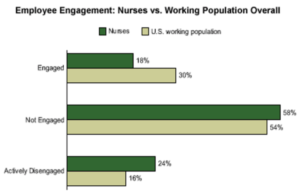Despite its noble intentions, the Triple Aim of healthcare may be causing more pain than intended, at least according to a study in the Annals of Family Medicine. And it’s no surprise that nurses and nurse managers are feeling the sting too.
In a previous post, we talked about how the pressure to enhance patient care, improve population health, and reduce costs is contributing to widespread burnout and dissatisfaction among those on the front lines of patient care. In turn, the side effects are ricocheting across all areas of the Triple Aim, negatively impacting everyone and everything it intends to benefit.
What’s going on? Benjamin Franklin may have said it best: “When the well’s dry, we know the worth of water.”

Nurses are stretched thin, balancing greater expectations around quality patient care with more time required to document care processes in EMRs. As a result, more than 50 percent of full-time nurses work an average of 7 hours of overtime each week. And too much overtime eventually results in job dissatisfaction and turnover. As a nursing shortage looms and hospital workloads expand to meet accountable care standards, the situation isn’t likely to improve anytime soon.
How can facilities fill up their wells and then keep them from going dry? Focus groups show that when nurses experience good and healthy work environments, patients have more positive experiences of nursing care. That is, taking good care of patients requires taking good care of nurses. And today that’s not happening enough.
Some say the answer lies in adding a fourth dimension to the Triple Aim. A Quadruple Aim would focus on improving care providers’ work lives and validate their roles in achieving the goals of the Triple Aim.
What would a fourth dimension look like for nurse managers and nurses? Certainly giving both parties more support would help. But adding more staff isn’t the only answer. It really comes down to engagement: the opposite of burnout. And more work needs to be done there. A Gallup study found that 24% of nurses are actively disengaged with their jobs and only 18% are engaged.
When nurses are enga ged, patient care improves and the patient experience is better. And in the value-based care era, that’s better for every facility’s bottom line. In addition, when low engagement results in turnover, facilities pay dearly. According to the Journal of Nursing Administration, it costs $82,000 to replace a nurse.
ged, patient care improves and the patient experience is better. And in the value-based care era, that’s better for every facility’s bottom line. In addition, when low engagement results in turnover, facilities pay dearly. According to the Journal of Nursing Administration, it costs $82,000 to replace a nurse.
To keep nurses engaged, those in charge must improve working conditions, and we’ve just released a white paper outlining specific tactics for doing just that. In our research, we found three key factors that can help:
- Giving nurse managers and nurses more control: Most of us feel better when we have the freedom to do our jobs, our way. In nursing, this is especially true. Empowerment here creates a special trifecta. When nurse managers are empowered, they can take better care of the nurses in their charge—including giving them more room to do their jobs. That, in turn, has a direct impact on patient care. Nurse managers must feel empowered to motivate their staff and achieve excellence in their roles. And nurses must feel the same to improve patient safety, care quality, and patient satisfaction.
- Getting everyone to work together: In nursing, higher levels of teamwork have been shown to increase job satisfaction. And when team members collaborate, patients benefit too. Still, staff collaboration is just one element in improving communication. Management also needs to get involved, helping filter communications so the nursing staff isn’t burdened with distractions that threaten their autonomy and their ability to focus on the work at hand.
- Making staffing and scheduling work for everyone: Studies show that working conditions and schedules have the greatest influence on overall job satisfaction among nurses, even ahead of salary. Hospitals can empower nurse managers by letting them have more control over how staffing and scheduling are managed. As we wrote in our previous post, technology like Nursegrid Manager can help with that by making it easy for nurses to initiate shift swaps or giveaways based on their own needs, and giving nurse managers an easy way to oversee approvals and flex staff up or down based on nurse availability and preferences. And Nursegrid Mobile, our free mobile app for nurses, can give nurses a quick and simple way to manage their schedules and connect with colleagues and managers.
The Triple Aim needs some wound care, and a fourth dimension just might be the right salve. For more ideas on nurse engagement and the Triple Aim, check out our new white paper.
In the meantime, we’d love to hear about your experience and your thoughts about how to take better care of those on the front lines of care.
Get our latest white paper on nurse engagement and retention.
